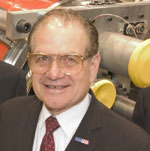Commentary: Ray Orbach
"Physicists think they have a pretty good story to tell these days, about the big bang, black holes, dark energy, extra dimensions and multiple universes. In the 30 years I have been following this stuff, it has never been wilder. But the real best seller here is wonder….There's a whole universe out there, and nobody knows how or why."
Dennis Overbye, New York Times, July 27, 2004
 Photo: Fermilab |
These are unusually exciting times to be a physicist. At the dawn of the new millennium, some of the essential questions for humanity have taken a new urgency. What is our universe made of, and how did it get to look the way it does? What is the underlying nature of space and time?
Particle physics addresses these questions at the level of the fundamental constituents of our world. For several decades now, the Standard Model of particle physics has netted success after success—including a string of historic experiments at SLAC and Fermilab. The Standard Model is arguably the most thoroughly validated physical theory in history. Yet it is known to be incomplete.
Striving for ever-more-sweeping answers to the great questions, we must now transcend the Standard Model. We must search for hidden symmetries of nature, new theories of gravity, perhaps even new dimensions of space. And as recent breakthroughs in astronomy have made clear, the world we have framed so far is but a small fraction of what is out there: We still cannot identify 95 percent of the universe's contents!
Like expert cartographers who suddenly face the discovery of an uncharted continent, physicists are now eager to map the mysteries of the new cosmos. Particle physics will play a crucial role in that quest, as it asserted with renewed energy and enthusiasm in the recent High Energy Physics Advisory Panel report Quantum Universe.
There could not be a better time to launch an innovative venture like symmetry. The new magazine will be living proof that even the most esoteric stories can be told in an engaging and accessible way. But symmetry will not only be a place for sharing the sense of wonder of the scientific enterprise; it will also provide the means for the science community's constituents to respond and share their own views.
symmetry is published by SLAC and Fermilab, two outstanding venues for the advancement of particle physics, its sister fields, and its applications—from astrophysics to nuclear physics, from nanotechnology to medicine. This joint effort underlines the two laboratories' history of collaboration as well as stimulating competition.
Laboratories and universities are not only invaluable national resources but also cauldrons of international exchange of ideas and agents of international cooperation. symmetry will portray the worldwide nature of the particle physics community, at a time when the community's vision for the future—with CERN's new Large Hadron Collider nearing completion and government discussions underway for an International Linear Collider—will strengthen international ties even further.
We at the Department of Energy salute the founding of symmetry as an inspiring forum for communicating and discussing the revolutionary particle physics of the 21st century.
Dr. Raymond L. Orbach is the Director of the Office of Science at the US Department of Energy (DOE). He manages an organization that is the third-largest federal sponsor of basic research in the United States, with annual funding of more than $3.3 billion, with programs in high energy and nuclear physics, basic energy sciences, magnetic fusion energy, biological and environmental research, and computational science.
Click here to download the pdf version of this article.


